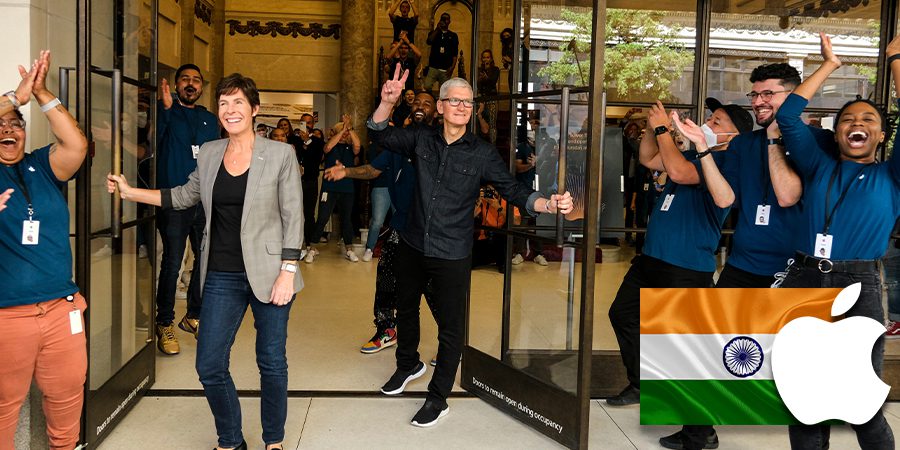In this article, we’ll look at the reasons behind Apple’s growing interest in the Indian market, the company’s first two retail stores opening, and its increasing commitment to local manufacturing.
Key Takeaways:
- Apple opening first two retail stores in India
- App Store payouts to Indian developers tripled since 2018
- Apple supports over 1 million developer jobs in India
- Increasing commitment to local manufacturing and exports
- Expansion plan to make India a key global hardware manufacturing hub
Apple’s Long-Standing History in India
Apple has enjoyed a relationship with India spanning over two decades, gradually making its presence felt in the South Asian nation.
This week marks a significant milestone in that relationship as Apple CEO Tim Cook visits India to inaugurate the company’s first two retail stores and meet with Prime Minister Narendra Modi, as well as several business leaders.
Apple’s commitment to India is apparent through its support for local communities, investment in development, and the introduction of innovations that serve humanity.
Opening First Retail Stores and Supporting Local Developers
Apple has plans to launch its inaugural retail shop in Mumbai, and is also intending to establish another shop in Delhi, indicating a substantial increase in their presence within the Indian market.
These new stores will provide Indian consumers with a more accessible and immersive Apple experience.
As part of its commitment to the local developer community, Apple now supports over 1 million developer jobs in India, with App Store payouts to Indian developers having tripled since 2018.
This support has fostered a vibrant app development ecosystem that continues to grow and create opportunities for Indian developers.
Aiming for Growth in the Indian Market
Despite being the world’s second-largest internet market, most smartphones sold in India are priced below $250.
Although India currently accounts for a small portion of Apple’s overall revenue, the company is optimistic about the potential for growth in the region.
The opening of the new retail stores signifies a significant expansion for Apple in India, and the company is actively recruiting employees to support this growth.
Although the opening of the first retail location was initially planned for 2021, the COVID-19 pandemic forced a delay.
With these new stores, Apple aims to capture a larger share of the Indian market and capitalize on the country’s growing appetite for premium smartphones.
Manufacturing and Exporting from India
Apple is making efforts to turn India into a major global manufacturing center for hardware.
The Indian government is providing incentives to manufacturers who expand their operations in the country, which is helping Apple achieve this goal.
In the previous fiscal year, Apple exported over $5 billion worth of smartphones from India. This accounts for nearly half of all exports from the country.
Foxconn and Wistron, the company’s partners in contract manufacturing, have recently increased their production of iPhones and other Apple products in the local area.
A report from JP Morgan analysts predicts that Apple will increase its manufacturing capability in India, with a goal of producing 25% of all iPhones in the country by 2025.
This expansion will support hundreds of thousands of jobs across the country, further bolstering India’s growing technology sector.
Apple’s focus on manufacturing in India has led to the production of several iPhone models in the country, including the iPhone SE, iPhone 12, iPhone 13, and iPhone 14 (basic) models.
This local production is facilitated through Apple’s Taiwanese contract manufacturers — Foxconn, Wistron, and Pegatron.
As a result, India has become an increasingly important part of Apple’s supply chain diversification strategy.
Challenges for Indian Apple Customers
While Apple’s expansion in India brings several benefits, there remain challenges for Indian customers.
Apple products, including the iPhone, are often prohibitively expensive in India, making them less accessible to a large portion of the population.
For example, the base model iPhone 14 Pro, priced at $999 in the U.S., retails for close to $1,600 in India. This price disparity extends to other Apple products and accessories as well.
Furthermore, Indian Apple customers do not have access to several popular Apple services, such as News+, Fitness+, and Apple Pay.
The Apple Card, which comes with a savings account, is not currently offered in India.
Additionally, Apple Maps and Siri offer fewer features to Indian customers compared to their U.S. counterparts.
In contrast, global giants like Google, Facebook, Amazon, Walmart, and Samsung have invested billions of dollars in India over the past decade, providing almost all of their global services to Indian customers at affordable prices.
For instance, Google Pay and Walmart’s PhonePe are leading the mobile payments market in India, offering a wide range of features and services to customers.
Despite these challenges, millions of Indian consumers continue to purchase Apple products, even when they feel like second-tier customers.
Tim Cook’s visit to India, while a noteworthy event, has yet to bring about substantial change for the country’s Apple enthusiasts.
However, the opening of the first retail stores and the company’s increased efforts to assemble iPhones and other products in India indicate a growing commitment to the Indian market.
As Apple grows in India, it’s important for them to face these issues and make sure Indian customers have the same quality of service as customers in other places.
This will involve making Apple products more accessible and affordable, as well as expanding the range of services and features available to Indian customers.
By doing so, Apple can solidify its position in the Indian market, capitalizing on the country’s growing demand for premium smartphones and fostering a loyal customer base.
 Sections of this topic
Sections of this topic
















